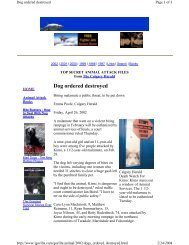A community approach to dog bite prevention - American Veterinary ...
A community approach to dog bite prevention - American Veterinary ...
A community approach to dog bite prevention - American Veterinary ...
You also want an ePaper? Increase the reach of your titles
YUMPU automatically turns print PDFs into web optimized ePapers that Google loves.
appropriate behavioral training, and supervision of<br />
interactions between <strong>dog</strong>s and children. Citizens must<br />
understand that pet ownership is an ongoing responsibility,<br />
not a passive activity.<br />
Dog owners can be provided with information<br />
through various avenues. Veterinarians and their staff<br />
are logical educa<strong>to</strong>rs and distribu<strong>to</strong>rs. Local <strong>dog</strong> clubs<br />
and trainers provide services <strong>to</strong> more conscientious<br />
owners. Businesses that sell pet foods and supplies<br />
should also be encouraged <strong>to</strong> provide <strong>bite</strong> <strong>prevention</strong><br />
materials <strong>to</strong> their cus<strong>to</strong>mers. Information can be distributed<br />
with utility bills, and animal shelters can provide<br />
classes for people who are considering acquiring a<br />
pet. Incentives for attendance at <strong>bite</strong> <strong>prevention</strong> classes<br />
could include reduced fees for licenses and coupons<br />
for vaccinations, food, and obedience classes. The most<br />
difficult group of <strong>dog</strong> owners <strong>to</strong> reach is those with<br />
minimal attachment <strong>to</strong> their pets. Although strong<br />
enforcement of local regulations will change some<br />
owners in<strong>to</strong> former owners, most will continue <strong>to</strong> own<br />
<strong>dog</strong>s. Therefore, education should be an integral part<br />
of any enforcement program. A good working relationship<br />
with the judiciary is critical so that offenders of<br />
animal-related ordinances are required <strong>to</strong> take courses<br />
that emphasize responsible ownership.<br />
Target group—Primary targets are adults who<br />
already own <strong>dog</strong>s.<br />
Secondary efforts—Secondary targets are adults<br />
who are considering getting a new <strong>dog</strong>.<br />
Identifying instruc<strong>to</strong>rs—Information for this target<br />
audience can come from various sources, and its distribution<br />
should be <strong>approach</strong>ed in a number of ways.<br />
Animal control officers and members of the legal profession<br />
can describe what is expected regarding local<br />
regulations and the serious consequences if these regulations<br />
are violated. Veterinarians and their staff can<br />
educate owners about vaccinations, neutering,<br />
restraint, and other health care issues. Dog club members<br />
and trainers can assist by providing socialization<br />
and training instruction and can help educate owners<br />
about being good <strong>dog</strong>-owning neighbors.<br />
Victims—When someone becomes a <strong>dog</strong> <strong>bite</strong> victim,<br />
a teachable moment is created. How useful that<br />
moment becomes in preventing future incidents<br />
depends tremendously on the seriousness of the <strong>bite</strong><br />
and the fear response of the victim. Scare-producing or<br />
threatening events are good times for <strong>dog</strong> <strong>bite</strong> <strong>prevention</strong><br />
information <strong>to</strong> be conveyed. However, the time<br />
surrounding a serious injury is generally <strong>to</strong>o emotionally<br />
charged <strong>to</strong> be of value for <strong>dog</strong> <strong>bite</strong> <strong>prevention</strong> education.<br />
Who provides information <strong>to</strong> victims depends, in<br />
part, on who is contacted about the incident. In addition<br />
<strong>to</strong> medical personnel, animal control’s investigative<br />
efforts usually require a home visit. Routine visits<br />
<strong>to</strong> a physician should include gathering his<strong>to</strong>rical<br />
information about the patient’s interactions with <strong>dog</strong>s<br />
<strong>to</strong> identify patients who would benefit from additional<br />
education. Media s<strong>to</strong>ries that reinforce correct<br />
<strong>approach</strong>es <strong>to</strong> <strong>prevention</strong> can also <strong>to</strong>uch many when<br />
they are most receptive.<br />
Target group—Individuals who have recently been<br />
bitten by a <strong>dog</strong> seriously enough <strong>to</strong> require medical<br />
attention but not so seriously as <strong>to</strong> have sustained<br />
severe injuries are the primary target.<br />
Secondary efforts—Secondary targets are individuals<br />
who have been bitten by a <strong>dog</strong> in the past.<br />
Identifying instruc<strong>to</strong>rs—Medical professionals and<br />
animal control personnel are the individuals who<br />
encounter this group.<br />
Businesses—Community businesses need <strong>to</strong><br />
address <strong>dog</strong> <strong>bite</strong> <strong>prevention</strong> as well. Certain businesses<br />
(eg, veterinary clinics, grooming and boarding facilities,<br />
animal control, pet sitting agencies) revolve<br />
around direct contact with <strong>dog</strong>s, and employee education<br />
is critical from a safety and liability standpoint.<br />
Employees of other businesses will occasionally<br />
encounter <strong>dog</strong>s in the course of their daily job activities<br />
(eg, utility workers, police officers, parcel carriers,<br />
and emergency medical technicians). Training conducted<br />
by an animal control officer or other knowledgeable<br />
professional may provide employees with the<br />
<strong>to</strong>ols they need <strong>to</strong> safely handle contacts with at-large<br />
animals, attack/guard <strong>dog</strong>s, or <strong>dog</strong>s who simply reside<br />
on the premises of those facilities where they do business.<br />
Target group—Primary targets are employees and<br />
business owners who will be working with <strong>dog</strong>s on a<br />
daily basis.<br />
Secondary efforts—Employees of companies who<br />
are likely <strong>to</strong> encounter <strong>dog</strong>s in their daily business<br />
activities can be considered secondary targets.<br />
Identifying instruc<strong>to</strong>rs—Animal control personnel,<br />
veterinarians, veterinary technicians, and <strong>dog</strong> trainers<br />
who are experienced at dealing with <strong>dog</strong>s in a variety<br />
of environments. These individuals will need <strong>to</strong> cus<strong>to</strong>mize<br />
presentations <strong>to</strong> the type of situations most<br />
likely encountered by the target audiences.<br />
Media<br />
The local media play an important role in a <strong>community</strong>’s<br />
efforts at <strong>bite</strong> <strong>prevention</strong>. For this reason, it is<br />
suggested that 1 member of the advisory council or<br />
task force be a media representative. In addition, the<br />
advisory council can be proactive in helping the media<br />
convey important and appropriate messages.<br />
Sensational events provide an opportunity <strong>to</strong> convey<br />
important messages. Regular features can reinforce<br />
principles and keep educational efforts flowing.<br />
Know the media<br />
Your key <strong>to</strong> the public eye and ear is a selective up<strong>to</strong>-date<br />
list of local media contacts who have an interest<br />
in animal issues. Such a list can be developed by<br />
undertaking a comprehensive media survey. Check the<br />
local library for publications that list names, telephone<br />
numbers, and short descriptions of your <strong>community</strong>’s<br />
media outlets. Call each office or studio <strong>to</strong> discover<br />
which desks or departments should receive your<br />
inquiries and press releases. Read local newspapers and<br />
listen <strong>to</strong> local radio and television news and feature<br />
JAVMA, Vol 218, No. 11, June 1, 2001 Vet Med Today: Canine Aggression Task Force 1743










